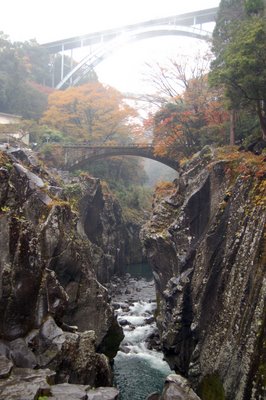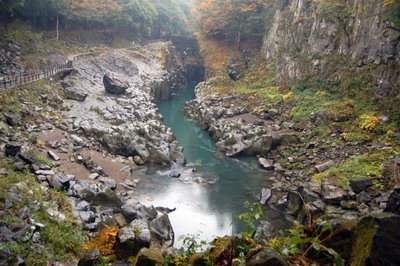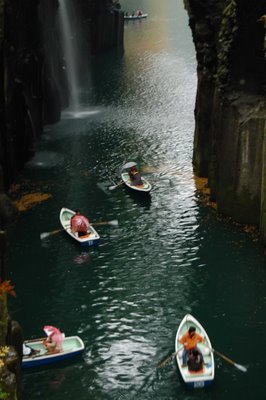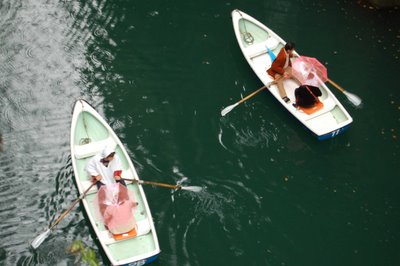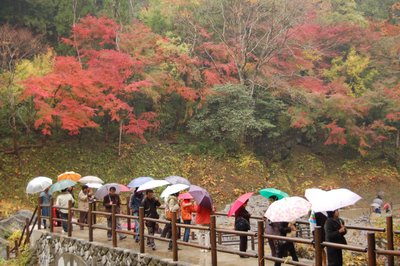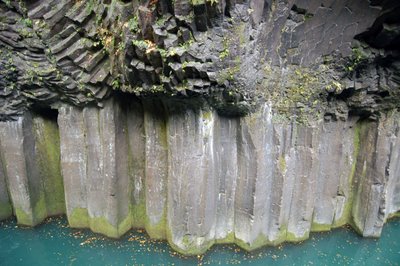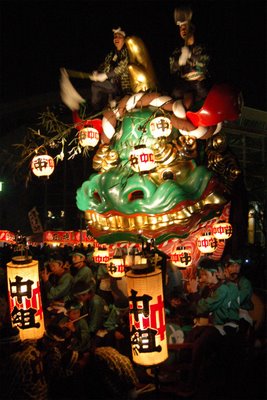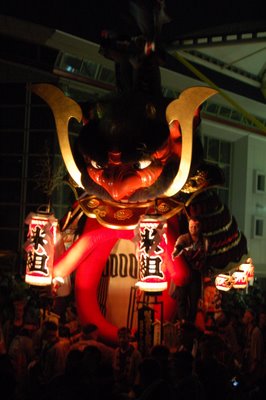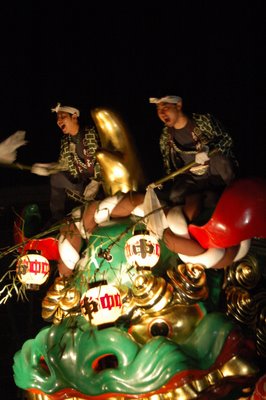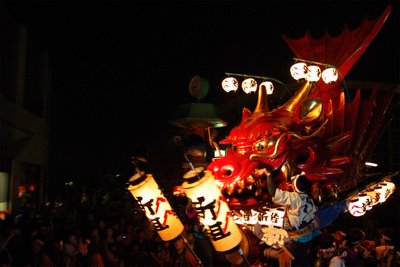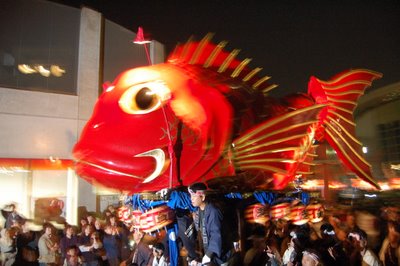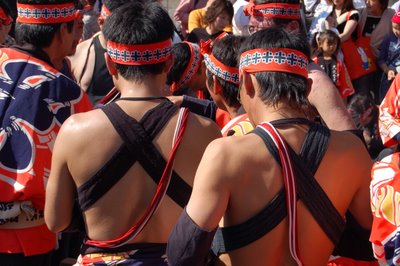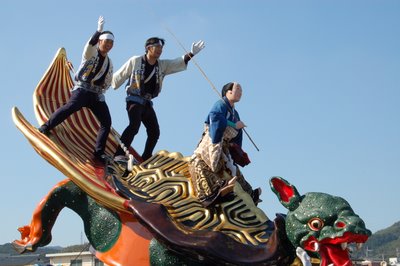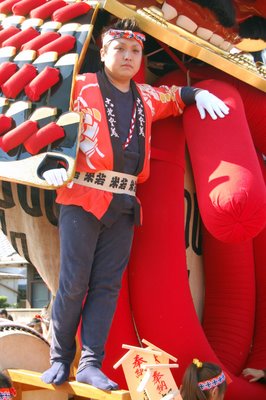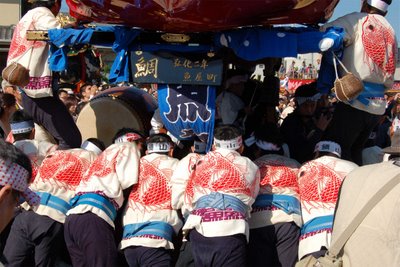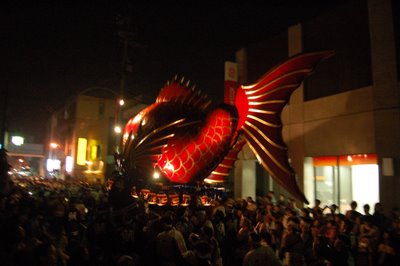In October, I read a short piece in a magazine about the traditional folk dances of the town of Takachiho, nestled up in the mountain ranges in the centre of Kyushu. The 33 different dances have been performed for centuries in the area, and a couple are danced each night in the town for an hour for the benefit of tourists. However, every dancing group (of which there are 19 in the town) also performs all 33 dances overnight, once each winter. The first of these dusk till dawn performances was on November 18th, so I got myself on a bus and headed out there. I left in the morning, and went to see the famous Takachiho Gorge in the afternoon (see
previous post).
Feeling rather grumpy from the rain and banged knee, I waded through the rain back into town around 4:30. I stopped in an empty coffee shop to dry out and pass the time, peeling off layers of rain gear and feeling very pleased to be wearing my boots. It was run by a very friendly woman who I just about managed to chat to in my broken Japanese. I asked her about a local delicacy I'd read about called 生妾湯 (shougayu), but she warned me that it was a powerful drink, best reserved for those with a sore throat or similar dire need. I insisted, and she promptly produced a knob of ginger, grated it, and poured in hot water. Slightly disappointed, I sipped my ginger tea, and explained that we drank it England too. She seemed similarly disappointed at the news.
After acquiring supplies (enough chocolate, rice balls, and coca cola to keep me awake for days - I had enough late-night essay sessions at Oxford to know how to eat my way through a long night), and dinner (fried noodles in a basic eatery where the cat was more talkative than its old-granny owner), I got myself a taxi. I had considered walking (only an hour in the rain...), and wisely decided against it, much to my relief as the cab wound through pitch-dark, steep, mountain roads. As we negotiated the forests, I talked to the driver. Obviously he asked where I was from, and it transpired that I was the first Englishman he had ever met. Given that Takachiho was supposed to be a tourist destination, and taxi drivers are about the most likely person of anyone in a town to meet foreigners, this said something about how isolated the town was - right up in the mountains, far from the cities, the Shinkansens, the airports.
Suddenly, we pulled up to a bright, neon lit room, open to the night on two sides, and bustling with people. I got out and the driver helped me get under cover with his umbrella. He seemed to ask the shrine people to look after me, at which they appeared rather non-plussed, before saying goodbye and driving back off into the dark forest. At around 8pm, the dances had already started, performed in a central square marked by hanging paper patterns and fresh green-leafed branches. The paper was cut doily-style; known as Erimono they represent each of the traditional elements of Wood, Fire, Earth, Gold, and Water. Sheets bearing the names of donors to the shrine were stuck up on the walls over the course of the night. The lighting was harsh, with bare neon tubes flooding the room with cold light. Outside, the rain poured onto one tarpaulin wall, but the large tatami room was clean, dry, and full with a seated crowd. Stage left a musical ensemble was set up; the instruments changed from dance to dance, but most used a Japanese flute (Yokobue), with a sweet whistling quite unlike the broken sound of the Shakuhachi, and the ubiquitous Taiko drum, hit with two sticks on the rim and the skin, using simple, sharp rhythms - bomBOMMM dadadat, dadadat, dadadat; bomBOMMM dadadat, dadadat, dadadat; bomBOMMM dadadat, dadadat, dadadat...

So to start, I got myself a little patch on the tatami, and settled down to watch, trying to ignore the staring eyes of several people in the crowd, after a brief nod/bow of acknowledgement (I hadn’t seen another foreigner all day, and I guess I presented something of a novelty). Here at last was the Yokagura (folk dances) I'd come to see. The men danced before a small shrine, lined with masks for the performance, a range of fresh vegetables, sake, and a single candle; all offerings to the gods in hope of a good harvest. They wore blonde wigs, rough as straw, over their black hair. The men were a range of ages, from early twenties up to the late forties. They wore white robes, with very wide sleeves stretching a foot and a half down from the wrist. A variety of garments were placed over the top, sometimes broad sackcloth, other times a twisted scarf around the shoulders to keep the sleeves out of the way. Some dancers held an ornate fan, or a sword, or often a Suzu - a gold, jangling ritual implement with no obvious use other than shaking and ringing like little bells.
I have to admit to being a little disappointed at the quality of the dancing. Though they did not suffer that immense sense of social embarrassment that (nearly) every English Morris Dance group displays, and which makes them so painful to watch, these dancers did seem a bit shy, a little uncertain. Occasional mistakes, downward-looking eyes, half-hearted movements, took a lot of the shine off the performances.
But when they wore masks, there was a very different feel to their movement. They were prouder, stronger, less shy. In the interval between dances, a man would approach the shrine, bow, take a particular mask from the ranks and place it on a tray, and with great respect and care carry it backstage. Some masks gurned, some showed a winsome smile or fanged grimace. They ranged from fierce monster and great hero to young maid and grimy old granny. One particularly impressive mask was battered and peeled, the red lacquer broken off in great flakes like a leper's lost nose. It's wearer suddenly ran into the crowd, gibbering and waving, and sent his 6year old son screaming for his mother. Afterwards the dancer crept round unmasked and reassured his child that he really was no devil.
One dance saw a strong but slightly gawky young man in a gurning, think-lipped mask, sporting a top-knot like a straw onion.

He drew his arms back and forth, swaying rather awkwardly, gearing up for a roll and balance on his shoulders. He rocked and rolled around the stage, before pausing on his knees. The other men scuttled a large Taiko drum onto the stage, and knelt around it as support.

Like a wild imp, he jumped on the drum, seized the sticks and sitting in a feral squat pounded out his rhythm.

Then, in an impressive feat of strength and balance, he tilted his weight forwards onto his arms, dropped his shoulder to the drum, and raised his legs into the air. He kicked and danced his legs spasmodically in time with the drum.
Another dance climaxed with a god unleashing a terrible storm, and suddenly a Heath Robinson rope contraption shook and rocked the roof frame and paper hangings as with a wild wind.
Then, with serious faces and long sleeves tied back, they brought out the swords.
First the local priest took the time to bless them, and then the six men held out their swords and grasped their neighbour's by the tip. They danced around in a circle, rotating in skips, aiming their swords with care away from each other. Their faces pinched; this wasn't the time to screw up.
One awkward moment saw a guy turn at the wrong moment, and his friend pushed the sword blade away from his oncoming guts at the last moment. They caught each other's eye for a moment - do not do that again.
One by one the men dropped out until it was just the three youngest men on stage.

They turned and worked the rotations.

Suddenly, they threw themselves into a salsa whirl, spinning on the sword grips like a writhing knot.

They tied, and then untied, their bodies.

Until suddenly they were back where they started, breathing heavily and looking very relieved.

One of the three bowed out, and the remaining two were blessed again by the priest.

Again they turned slowly, skipping and rotating, before spinning wildly, swords over there heads bending and curving.
And then one more dropped out, and the youngest of the lot knelt alone before the priest, and received his blessing. He held his two swords against his body, and rocked and skipped around the stage, before gearing up for a whirling torrent of sword strokes.

The whole dance took ages to work through all the permutations, maybe as much as 45minutes, and by the time you've seen a man rock, sway, and lash out at one point of the compass, the next three are pretty predictable. He had to swing the swords by the handle, then holding them by the sharp tip, and finally in the middle - and then work back through them all one more time. But then that's where you see the difference between dance and religious ritual. These dances are offerings to the gods, hoping for a rich harvest - you can't skimp on offerings, you can't cut corners. If you dance one way, you must dance four; if one man dances away, they must all dance away in turn, until no one is left on the stage. This is being, not doing.
Each dance had a name and myth behind it. The great myth underlying all the dances is that of Amaterasu, the Sun Goddess who ran off in a huff at her brother's offensive behaviour, and hid in a cave just near Takachiho. The disappearance of Sun goddesses is rather problematic (try looking for a hidden torch in a dark room), so all the gods set out to bring her back to her position in the skies. Nothing worked, not prayers, entreaties, or chants. Finally, an enticing dance brought Amaterasu out of the cave; it just looked to good to miss out on, and she wanted to join in herself. But before she could, the gods pounced on her, and forced her back up into the ether.

I've no desire to compare myself to a sun goddess, but I can certainly understand her feelings of envy at the dancing divinity outside her cave. Whenever I watch dance, I get restless and want to join in. The most upsetting thing about the dance was the dense rank of photographers around the stage. When a masked performer made wide movements, or did something novel, they would click and clatter away. But when the performer was unmasked, or the dance was slow or subtle, the photographers just stared at the floor, or checked their cameras, ignoring him completely. They had no sense of this as performance, just as series of opportunities to take 'a good photo'. Like leeches, they sucked the blood of the atmosphere. So, I didn't take many photos in the end. I didn't want to document it, I wanted to be a part of it!
And, to my great surprise, I eventually did become a part of it.
Over the course of the evening, about a third of the audience taxied off in the rain, tourists returning to warm hotel beds. As the crowd thinned the atmosphere became warmer, more communal. Cups of Ocha (green tea), misu soup, warm mochi (rice cakes), were handed around to all with great warmth (Japanese hospitality is beyond measure). Then, around 11pm, the proceedings all stopped, and the dancers sat around a large table on the stage, and were served a fine meal of sushi, rice, fish, meat, sake. I looked up over the cross-legged crowd, and saw a man talking to one of the dancers, and pointing and looking at me. They all beckoned me over, wanting to speak to the foreigner. Having only been here for two and a half months, my Japanese was very poor, but I managed to squeeze out the requisite info re origins, purpose, home etc. And yes, of course I enjoyed the dancing, it looked great. Then an intelligent-looking man (perhaps just because he wore spectacles), asked me a question...
'Would you like to try?"
"Hai!"
Yes, yes I really did want to try it.
He smiled knowingly, and no more was said. I sipped my sake, tried to follow the chat (and failed), and returned to my spot on the tatami to see the next dances.
But my new bespectacled friend crept round the back, and whispered to me in Japanese:
"you really want to try?"
'YES!"
"Then come this way..."
We snuck out the back, as the dance began, and he led me round the back into the dressing room. I entered a bright, neon-lit room, with costumes hung and draped over every flat space, and swords, gold implements, fans stacked and scattered everywhere. Standing around a warm brazier, a large box of tangerines, and a stack of caffeine drinks, was a group of nine men in white robes, staring at me. I bowed and said hello, and they laughed and smiled at me. Basic chat followed, and they seemed pretty pleased to have a novelty foreigner in their midst. Then a man handed me a spare set of white robes, and helped me change. A long white jacket, with flowing trousers somewhat like pantaloons. But they didn't have a spare set of white boot-socks - what to do? Luckily I was wearing white socks, and those would have to do they decided. I stood admiring myself, dressed head to toe in authentic shinto garb - that is, apart from the red nike ticks on my socks...
They wrapped a red band around my head, and handed me a red mask - a silly, grinning man. And then it clicked - they were setting me up for a fall, getting the foreigner on stage so everyone could laugh at me as I tried to follow the moves, clueless and dithering. My heart beat a little faster as they pressed the wooden mask over my face, making breathing more difficult and reducing my vision to two small holes about one and a half cm across, before wrapping my head in a red cloth bonnet - a foolish rice farmer, the butt of all the jokes. I turned my tiny eyes to the man who had placed it on my face, and asked in Japanese a very simple question - what do I do?
He laughed as he handed me a fan - "furee dansu," he said, using the Japanese version of 'free dance'
i.e: you're on your own kid.
Next he handed me a 3ft bamboo stick with bright green, red and white paper tassles on each end. A magic wand!
The dance had already begun, with the first man in a monster's mask dancing with a 6ft staff to a fast rhythm - much hitting the tatami and aggressive posturing. I fiddled with the mask as I watched the next man go out. The first monster stood on a box, watching the intruder enter the stage, and tolerating his dance for a few minutes before driving him off with his staff, and forcing him to sit on his knees on the edge of the audience.
I was to be the fourth man out of six, and breathed heavily as I waited my turn. Then one gave me a friendly nudge, and sent me out. Clearly my debut was no secret, and as I picked my way through to the stage the crowd had already started laughing. Ducking under the paper webbing, I took my turn around the stage. The flicking, sharp rhythm was so compulsive that I couldn't help but dance, and really got into my own version of what I'd seen the other men do. I held the wand over my left wrist, and spun round to the right, jolting on my heel, before repeating it on the other side. Soon enough the monster's staff appeared before me, and I was ushered off his territory. I knelt, sweating in my mask, flushed with relief, trying to watch the next man's dance, this one a silly young maiden with a tiny face and tight lips. Small hands to her chin, petite movements; you could almost see her flutter her eyelashes.
As he was swept down next to me, I caught his gaze through the tiny holes. He pointed to my hand, and showed me how to open my fan and hold it correctly, and the helpful gesture really put me at ease. Once the last man had appeared and been pushed off, we went through the reverse pattern, each man getting up, dancing and being sent back stage by the masked giant. As my turn arrived, I jumped up, confident now and ready to make the most of my final 2minutes as a participant of a genuine Shinto ritual.
It was clear that I only had one option, and so played up to my mask's role for all I was worth. My dance was silly, flouncy, and I twirled my stick like the proud, priggish fool that I had become. Then I turned to a clown's stomping, bottom-waggling clowns dance, and the grannies, mums, villagers and children of the crowd fell about laughing. Finally, the monster swept me off, and I got a round of applause from the good people of Takachiho. I think they must have seen the Nike ticks on my socks.
I found out later the dance was called 七貴人 (the seven nobles) - with one chief god (the monster) followed by six child gods, one of which was me.
Back in the dressing room, I got my mask off, and the men nodded their approval of my dancing. I returned my fan and magic wand, and settled down to a well earned tangerine.
I then got a chance to actually talk to these guys, as they rested in the dressing room between dances, eating tangerines and rice cakes, drinking green tea and brutal caffeine drinks with the occasional shot of sake. The man who had invited me to join was the only one who could really speak English, and he was very polite, quietly reserved but very kind. I asked another man of a similar middle age why he did these dances, and his answer was simple - because he enjoyed it. He worked in a bank, played the Yokobue, and danced the Yokagura.

The younger guys were much more forthcoming: a proper country guy, working to support the kids he'd fathered at 21 (my current age - natch), calm natured with a burly body and rough hands big as shovels, that he wrapped round the flute and danced lightly over its wholes. Then the two mates, a sharp, streetwise guy who wanted to be in London more than he wanted to be in Takachiho. His mate was a simpler and happier man - he was the masked one who scared his kids, the swordsman who swung them alone. They were a close pair, and looked after me. Here they are, dancing at 6am with ribbons over their ears.
As the hours worked by, the men from the local Miyazaki TV station interviewed me on camera (I don't think my halting attempts at Japanese made it to air - I'm hardly the best in front of cameras at the best of times). A later dance saw a rampant love affair between the petite girl (who had helped me open my fan), and a man in his 50s wearing the fool's mask I had worn when I danced. It was pure slapstick, filthy and funny in equal measure. They drank and wooed, before rushing off and trying to seduce (or just to hump) members of the audience. To cool their raging lust, they finally made love, rolling on the tatami, feigning oral and then swinging their hips in full banging fashion. The crowd was in hysterics, and completely cracked as the maiden wanked off her lover, her fist a blur in the air.
The man behind the mask was a real joker, his face wrinkled from years of laughter. When the two young guys danced together in dragon costume, going through the audience and biting all our heads with their magic jaws (a sure sign of good luck for the coming year), he was the guy who took a real shotgun outside, and fired off the bang that killed them (and nearly killed me from shock - those things are LOUD).

Completely different to him were the two oldest men. The group's teacher, who they all treated with great respect, was a rangy man in his 70s, brittle from arthritis and quiet as a stone. He watched it all happen before him, no advice and no applause, occasionally shifting his long bones. He only applauded once, at one of the last dances of the night. Around 7am, a man in his late 50s danced alone and without a mask, and for once he really MEANT it. (He's the one on the right of the large drum - he had an incredible calmness in his manner, shifting from smiles to concentration with ease). His movements were precise and tight, his face locked in a concentration that showed effortless power, not powerless effort. It really was an extraordinary dance, to which the rest of the group seemed largely oblivious. That was the real split between them - the joker's entertainment (of which I was a part), and the sincere prayer of solemn commitment. I would dearly have loved to have talked to that teacher, but he was taciturn, and I suspect resented my presence a little.

And presiding over them all was the priest of the shrine, a jowly man (right) who sat presiding over affairs from the side of the stage. He chain smoked throughout the night, and slumped over his belly asleep through the dead of the night. I formed a pretty bad impression of him, until I spoke to him as the dawn light seeped in through the tarpaulin wall. He was courteous and friendly (anyone would need to be to get through my Japanese at this point).

Best of all he presented me with a gift - the magic wand that I had waved and twirled over the stage. I still have it now in my room, though how I will get it back to England I don't know.
The young guys had called me a taxi back to town so that I would be able to catch my bus home, and as I got into the taxi they were still dancing on the now day-lit stage. The villagers milling around waved to me as we drove off, and I wanted to shrink into my seat, stunned by their open friendliness and hospitality.
As we drove into town, I saw the last thing that Takachiho is famous for. In Japanese it is called 雲海 (unkai), or Cloud Sea, and it stretched for miles of low, white, puffy clouds, clean and calm below the hill road that we took back into town.
 Every November, Fukuoka plays host to the last Grand Sumo Tournament of the year. The sumo circus starts in Tokyo, and holds contests in cities all over Japan, before it finally comes into town here. For weeks, Very Big Men in equally big kimonos stroll around town, turn up in bars, spread over two seats on the subway. Then, they fight one bout a day for the two week tournament, their ranking changing with every win and loss.
Every November, Fukuoka plays host to the last Grand Sumo Tournament of the year. The sumo circus starts in Tokyo, and holds contests in cities all over Japan, before it finally comes into town here. For weeks, Very Big Men in equally big kimonos stroll around town, turn up in bars, spread over two seats on the subway. Then, they fight one bout a day for the two week tournament, their ranking changing with every win and loss. But there are some very real differences - no ropes around the ring, so when the loser is hurled off the stage they land on the front row (no laughing matter, these guys average over 300pounds); the more expensive ticket buyers sit cross-legged and shoeless on cushions in their own little box; a stylised shrine roof hangs from the ceiling over the ring.
But there are some very real differences - no ropes around the ring, so when the loser is hurled off the stage they land on the front row (no laughing matter, these guys average over 300pounds); the more expensive ticket buyers sit cross-legged and shoeless on cushions in their own little box; a stylised shrine roof hangs from the ceiling over the ring. Underneath the seating, a neon-lit warren of waiting giants and busy henchman is there for all to see. Silverware is stacked up for the winner (and it ALL goes to the winner), while not so far away a chilling sign of the dangerous side of the sport - a huge wheelchair, the seat at least 3feet wide and back even longer, in wipe-clean tanned leather.
Underneath the seating, a neon-lit warren of waiting giants and busy henchman is there for all to see. Silverware is stacked up for the winner (and it ALL goes to the winner), while not so far away a chilling sign of the dangerous side of the sport - a huge wheelchair, the seat at least 3feet wide and back even longer, in wipe-clean tanned leather.
 The current Yokozuna - world champion - has all of those. He fights under the name Asashoryu (all foreigners must assume a Japanese name to take part), but he was born in Mongolia as Dolgorsuren Dagvadorj. He's won 70 of his last 78 bouts (and bear in mind that as champion he has to fight the second-ranked wrestler every day of every tournament). When he fought on the last day of the Fukuoka tournament, I saw a clear demonstration of why he has remained champion for so long.
The current Yokozuna - world champion - has all of those. He fights under the name Asashoryu (all foreigners must assume a Japanese name to take part), but he was born in Mongolia as Dolgorsuren Dagvadorj. He's won 70 of his last 78 bouts (and bear in mind that as champion he has to fight the second-ranked wrestler every day of every tournament). When he fought on the last day of the Fukuoka tournament, I saw a clear demonstration of why he has remained champion for so long. And they hold that gaze. For five seconds, they stared into each others eyes, bristling with aggression.
And they hold that gaze. For five seconds, they stared into each others eyes, bristling with aggression. The crowd erupted, first throwing shouts into the air, and then tossing purple seating cushions in spinning arcs over the crowd. Hundreds of soft shuriken buzzed around the stadium, flopping onto the ring and hasilty cleared by attendants.
The crowd erupted, first throwing shouts into the air, and then tossing purple seating cushions in spinning arcs over the crowd. Hundreds of soft shuriken buzzed around the stadium, flopping onto the ring and hasilty cleared by attendants.

















